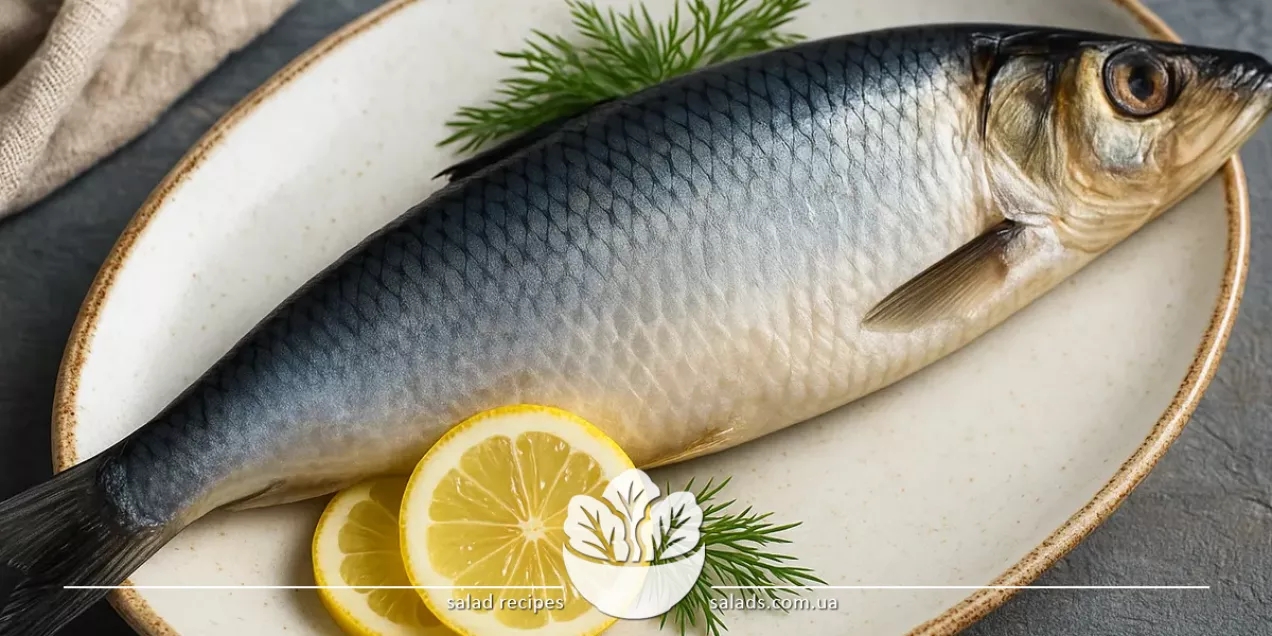
Salted Herring

Salted herring is a fish product made by salting herring in a strong brine solution. This method not only preserves the flavor qualities of the fish but also extends its shelf life without preservatives. Herring has a firm yet tender texture, a pronounced aroma, and a distinctive salty taste. It is often served with onions, oil, potatoes, or rye bread and is used as a base for salads and appetizers. In cooking, herring is valued for its versatility, depth of flavor, and ability to pair with a wide range of ingredients. Other types of fish can be found in the herring category on the website.
Salad Recipes with Salted Herring
Nutritional Value and Culinary Versatility
Salted herring is not only a delicious traditional dish but also a nutritious food product. One hundred grams contain approximately 17-19 grams of protein rich in essential amino acids, along with 10-15 grams of fat, a significant portion of which consists of omega-3 fatty acids. These fats benefit the cardiovascular system, reduce inflammation, and help regulate cholesterol levels in the blood. Additionally, herring contains vitamins D, B12, and PP, as well as trace elements like iron, zinc, iodine, and selenium. Salted herring retains the natural flavor of fish, which becomes more pronounced after a long period in brine. It is prepared either with bones or as fillets – the latter being more commonly used in salads and appetizers. Depending on the producer, herring may be classically salted, lightly salted, or seasoned with herbs and spices. When combined with other protein-rich foods, such as smoked ham, herring creates unexpected but fascinating culinary pairings. This duo is often seen in appetizers and fusion-style dishes, where the contrast between salty fish and smoky depth delivers a unique gastronomic effect.
Traditional Serving with Bread and Oil
One of the most classic and popular ways to enjoy salted herring is served with bread, onions, and unrefined oil. This dish is well-known across Ukraine as a festive appetizer, a complement to borscht, baked potatoes, or a standalone course. Herring paired with bread creates a simple yet balanced taste composition, combining saltiness, fattiness, acidity (from onions or vinegar), and the softness of the bread base. Traditionally, dark rye bread is used, but white bread varieties are increasingly popular – especially in the form of toasts, tartines, or sandwiches. This opens up opportunities for flavor experimentation, where the bread's texture plays just as important a role as the fish. A slice of crunchy or toasted bread topped with herring fillet, onion rings, and a drop of mustard or sauce makes for a quick, tasty, and nourishing snack. The best choice here is white wheat bread, as its neutral taste and soft texture complement the herring’s intense saltiness. Paired with herbs, pickled cucumbers, or boiled potatoes, this dish becomes even more expressive and satisfying.
Salads and Appetizers with Vegetables
Salted herring is a staple ingredient in many salads and cold appetizers. A classic example is “herring under a fur coat,” where the fish fillet serves as a base for layers of beetroot, potatoes, carrots, eggs, and mayonnaise. However, many other variations are equally popular in modern cooking. Herring pairs well with sweet-and-sour, fresh, or crunchy vegetables that balance its strong flavor and add textural contrast. Notable combinations include salads with apples, pears, cabbage, and seasonal vegetables. For lighter appetizers, herring is mixed with lettuce, cherry tomatoes, roasted beets, or even grapes. In such dishes, it’s essential to strike a balance between the fish’s richness and the freshness of the other ingredients, which is why dressings based on mustard, oil, lemon juice, or natural yogurt play a key role. One of the best vegetables to pair with herring is sweet bell pepper. Its juicy texture, mild sweetness, and vivid aroma contrast beautifully with the dense, salty fillet. Adding peppers to salads or herring canapés makes the dish not only more flavorful but also visually appealing – especially important for festive presentations.
Unexpected Pairings with Meat Ingredients
Although herring is rarely associated with meat dishes, its saltiness and fattiness allow for interesting combinations with animal-based products. In modern culinary practice, especially in fusion recipes, herring is used alongside bacon, brisket, sausages, and even pâtés. These combinations are based on contrasts in flavor – fishy and smoky, salty and caramelized, rich and tangy. For hot appetizers, herring can be served on crispy bread croutons with thin slices of brisket, topped with green onions or a spicy sauce. Rolls or wraps with lavash, where fish and meat are layered together, are also popular. In such dishes, careful proportioning is essential to ensure no ingredient overpowers the other. A compelling pairing is salted herring with smoked pork brisket. Its bold aroma and delicate texture highlight the depth of the fish’s flavor – especially in skewer appetizers, tartlets, or savory toasts. This duo works well on festive tables or as part of creative home cooking.
Pairings with Fruits and Sweet-and-Sour Ingredients
Salted herring is traditionally associated with salty-spicy dishes, but it also shines in combinations with sweet-and-sour ingredients – especially fruits. This contrast helps balance the fish’s bold taste, adding freshness and sophistication to the dish. This approach is common in Scandinavian, Polish, German, and modern Ukrainian cuisines. Herring pairs wonderfully with apples, oranges, grapes, and cranberries. These are added to salads, used as toppings for sandwiches, or incorporated into sauces. Thanks to their natural acidity and light sweetness, fruits soften the aggressive fish profile, creating a harmonious flavor. One of the most common combinations is with fresh apple. A crisp, juicy apple is especially suitable for herring salads with sour cream or mustard dressing, as well as in more elaborate appetizers with beetroot, nuts, or herbs. These pairings highlight the versatility of herring and elevate it beyond a simple everyday snack, positioning it as a refined element of contemporary gastronomy.